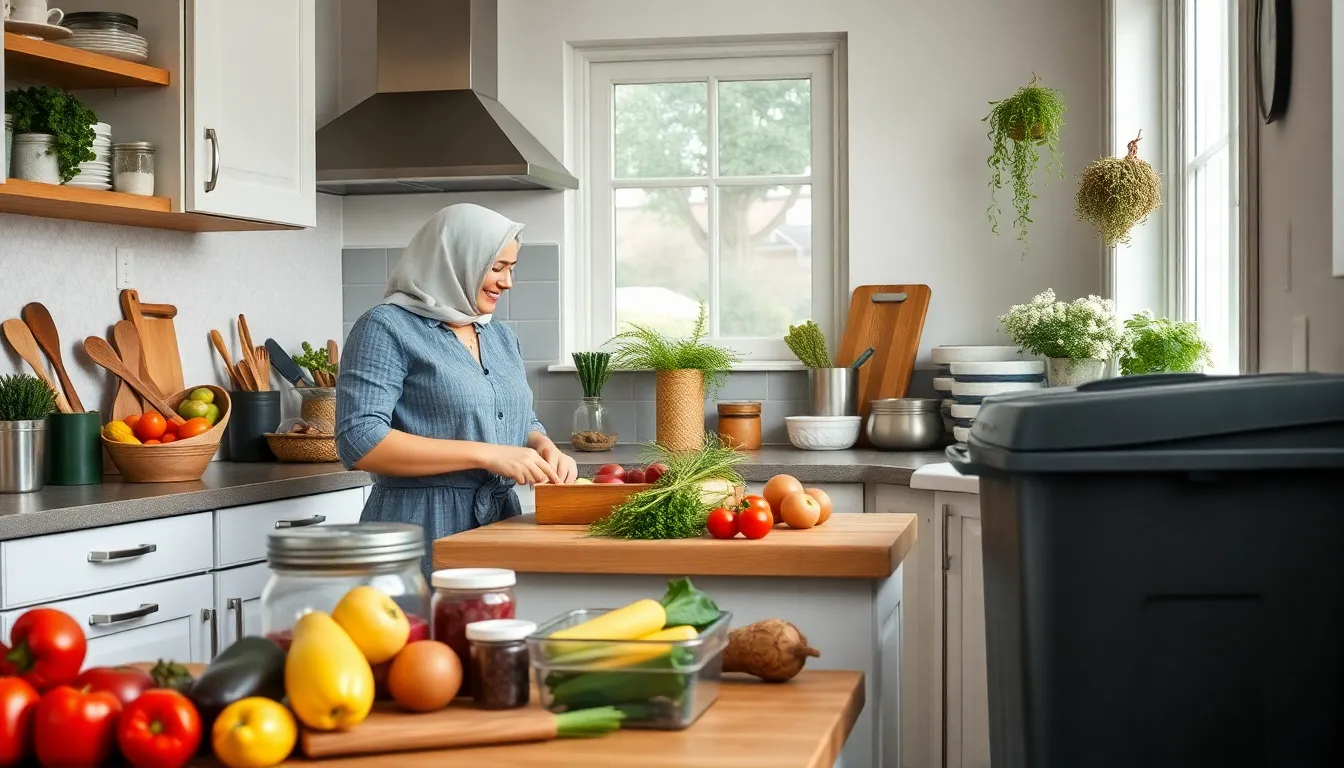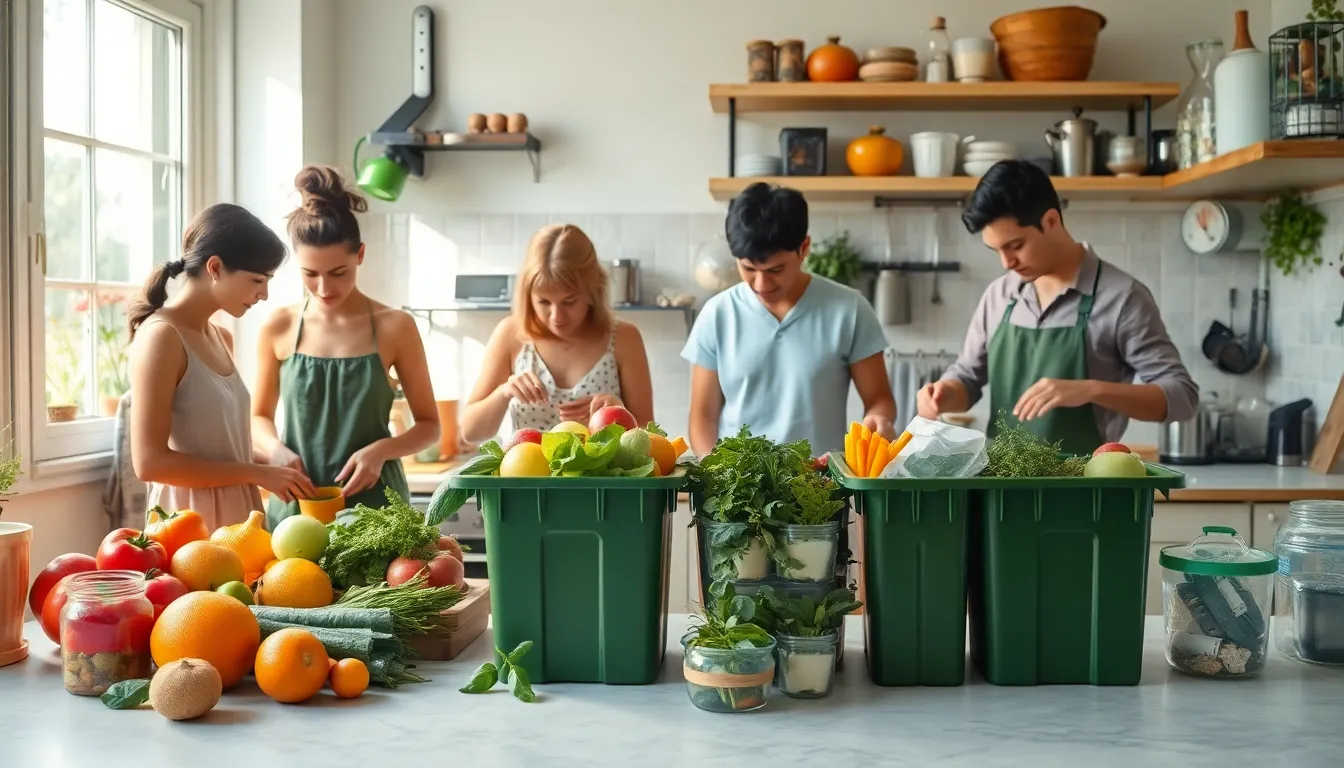Table of Contents
ToggleImagine a kitchen where every scrap of food is a treasure and every container has a purpose. Welcome to the zero-waste kitchen, where culinary creativity meets environmental responsibility. It’s not just a trend; it’s a lifestyle that turns trash into treasure and helps save the planet one meal at a time.
What Is a Zero-Waste Kitchen?
A zero-waste kitchen focuses on minimizing waste generated during food preparation and consumption. This approach prioritizes sustainability by using every part of food, ensuring that nothing goes unused. Meal planning becomes essential, guiding individuals in purchasing only what they need. Creativity plays a significant role, with many finding new recipes that incorporate scraps like vegetable peels or stale bread.
An organized kitchen supports the zero-waste movement. Containers, jars, and wraps made from sustainable materials help in storing leftovers and bulk items effectively. Composting food scraps allows for natural waste reduction, benefiting soil health. This method not only reduces landfill contributions but also enriches home gardens.
The philosophy extends beyond food. Reusable utensils, plates, and cloth napkins replace disposable options, reducing single-use plastic. Additionally, investing in energy-efficient appliances can cut down on overall resource consumption. Knowing how to repurpose old items also contributes to a more sustainable space.
Educational resources abound, offering tips for transitioning to a zero-waste lifestyle. Communities often share best practices, encouraging collaborative efforts toward sustainable living. A zero-waste kitchen embodies a commitment to environmental stewardship, promoting a harmonious relationship with food and nature. By being mindful of choices, individuals contribute positively to a healthier planet.
Benefits of a Zero-Waste Kitchen


A zero-waste kitchen offers significant advantages, not only for individuals but also for the environment. Implementing sustainable practices contributes to a healthier planet.
Environmental Impact
Reducing food waste plays a crucial role in decreasing greenhouse gas emissions. Landfills produce methane, a potent greenhouse gas, from decomposing food. By composting scraps, individuals enrich soil and reduce landfill contributions. Protecting natural resources becomes feasible by utilizing every part of food. Sourcing ingredients locally minimizes carbon footprints associated with transportation. Promoting a zero-waste kitchen fosters biodiversity through better waste management.
Economic Savings
Individuals experience economic benefits through reduced grocery bills. Meal planning curtails impulsive purchases, leading to better food management. Preserving food and reusing scraps ultimately extends food life. Saving money occurs when cooking creatively with leftover ingredients instead of discarding them. Using containers effectively can eliminate the need for single-use items. A budget-friendly approach emerges by prioritizing sustainable practices.
Key Components of a Zero-Waste Kitchen
A zero-waste kitchen incorporates strategies that eliminate waste and enhance sustainability. Key components include using sustainable materials and employing food preservation techniques.
Sustainable Materials
Sustainable materials play a vital role in a zero-waste kitchen. Glass containers often replace plastic ones, minimizing environmental impact. Beeswax wraps provide an eco-friendly alternative to plastic wrap, offering safe food storage. Additionally, stainless steel utensils and cookware foster longevity and reduce waste. Reusable shopping bags contribute to a decrease in single-use plastic consumption. Compostable items like bamboo utensils and plates enhance end-of-life solutions, enriching soil while minimizing landfill contributions. Prioritizing these materials not only supports sustainability but also encourages healthier living practices.
Food Preservation Techniques
Food preservation techniques help extend the life of ingredients and minimize waste. Freezing offers a practical way to store surplus fruits and vegetables for future use. Canning captures seasonal produce, allowing for enjoyment year-round. Fermentation transforms food while enhancing flavors and nutritional value. Dehydrating removes moisture, creating lightweight snacks with long shelf lives. These methods complement an organized kitchen, facilitating efficient meal planning and reducing spoilage. Implementing these techniques ensures that every part of food is valued, reinforcing the zero-waste philosophy.
Tips for Transitioning to a Zero-Waste Kitchen
Transitioning to a zero-waste kitchen involves practical steps to minimize waste while embracing sustainability. Focusing on these strategies supports both environmental health and culinary creativity.
Planning Your Meals
Meal planning serves as a cornerstone for a zero-waste kitchen. Identifying recipes based on what’s in the pantry prevents over-shopping. Create a shopping list that reflects the planned meals, helping to avoid impulse buys. Consider using leftovers strategically by incorporating them into the week’s menu. Utilizing seasonal ingredients not only promotes freshness but also supports local farmers. Planning meals reduces food waste and encourages individuals to get creative with existing ingredients.
Composting Practices
Composting practices play a vital role in recycling kitchen scraps. Start by designating a compost bin for food scraps like vegetable peels and coffee grounds. Ensure that the compost remains balanced by adding a mix of greens and browns. Rotate the contents regularly to enhance decomposition. Local composting programs can offer guidance and resources. Engaging in composting enriches soil health while reducing landfill waste, aligning perfectly with the zero-waste philosophy.
Challenges and Considerations
Transitioning to a zero-waste kitchen presents several challenges. Adapting to new practices often requires significant changes in routine. Individuals may find meal planning time-consuming, but this effort leads to reduced food waste.
Ingredient availability poses another challenge. Seasonal eating can limit options, especially in areas where fresh produce isn’t readily accessible. Utilizing local food markets mitigates this issue while supporting community agriculture.
Behavioral adjustments also play a critical role. Cultivating awareness about food scraps and their potential uses is essential. Many may need to learn innovative recipes that incorporate leftovers and peels.
Storage solutions frequently prove problematic as well. Finding durable, eco-friendly containers needs consideration to avoid reliance on single-use products. Glass jars, beeswax wraps, and stainless steel containers serve as sustainable alternatives.
Composting introduces its own set of challenges. Maintaining a balanced compost bin requires understanding the right mix of greens and browns. Educating oneself on composting techniques helps ensure efficient decomposition.
Time constraints might deter individuals from pursuing zero-waste practices. Busy schedules often leave little room for food preparation and waste management. Finding efficient routines can enhance adherence to a zero-waste lifestyle.
Community support aids in overcoming these challenges. Engaging with local zero-waste groups fosters knowledge sharing and encourages collective action. Joining workshops can enhance understanding of sustainable practices.
Ultimately, these considerations highlight the commitment necessary to embrace a zero-waste kitchen. Each individual faces unique challenges, yet persistence leads to rewarding outcomes for personal and environmental health.




